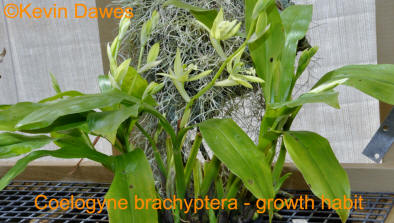Confusion over the identity of this Coelogyne is rife. It has been suggested that the image in Dudley Claytons book is incorrect and is actually Coelogyne chloroptera, which has yellow markings. I have also seen images on the web labeled Coelogyne brachyptera variety 'Yellow Lip'. Coelogyne brachyptera has no yellow markings (see images above).
The orchid above,(Coelogyne brachyptera or whatever!) exudes an understated elegance. The soft green flowers still manage to stand out from the green foliage. There are generally about 5 good size flowers, opening almost simultaneously, that rise nicely above the leaves, opening very fully and peering up to be admired. The black markings form just enough balance to highlight the delicacy of the flower and grab attention. They are certainly attractive.
This orchid grows in lower Burma, possibly also North Thailand and Vietnam on deciduous trees (i.e. in the same area as Coelogyne chloroptera). In this, case the trees are deciduous, not to avoid cold, but to avoid stress from the intense dry heat periods of the 'dry' season. This background suggests that this orchid likes lots of light, possibly a dry period and lots of water (with its resulting humidity) during its growing period.
My Coelogyne brachyptera lives in luxury in my glasshouse without any of its ancestors' harsh surrounds and has proved to grow with ease and produce lovely displays. None of us want to turn the clock back and live rough if there is an option of a better life! I mention this because some growers almost harp about emulating the native growing conditions. Most orchids I've seen growing wild look so battered and beaten that I wouldn't want to give them space in your collection!
There are a few other green flowering Coelogynes, such as the beautiful Coelogyne pandurata with long cascading flowers and the very large and common hybrid, Coelogyne Burfordiense. This hybrid needs a lot of space and is very masculine in comparison to Coelogyne brachyptera. A very worthwhile green option is Coelogyne mayeriana but it needs a lot of warmth.
Negatives: Needs warm, moist conditions and absolute protection from frosts.
Rating: ♦♦♦♦♦ Highly Recommended. This medium sized Coelogyne is perfect if you want a green flowering orchid.
Sometimes sold as: Coelogyne chloroptera, Coelogyne virescens and Coelogyne parishii
Varieties: None known
Hybrids:
1. Coelogyne Kirribilli Gillian (Kevin Dawes 2016) using Coelogyne mooreana "Brockhurst" as the pollen parent.
| < Coel bilamellata | Coel calcicola > |

